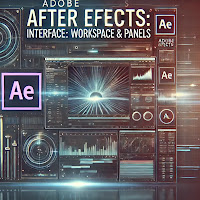Adobe After Effects: Interface, Workspace & Panels
Adobe After Effects has a customizable interface that helps you create animations, motion graphics, and visual effects efficiently. Let's explore the interface, workspace, and panels to understand how everything works.
1. Adobe After Effects Interface
When you open After Effects, you see multiple sections that organize your workflow. The interface is divided into:
- Project Panel – Manages your files and assets.
- Composition Panel – Displays your video or animation preview.
- Timeline Panel – Controls layers, keyframes, and effects over time.
- Effects & Presets Panel – Adds visual effects and transitions.
- Tools Panel – Contains tools like selection, text, and shape tools.
Each panel serves a purpose, making your work smoother.
2. Workspace in After Effects
A workspace is a preset layout of panels designed for different tasks. You can switch between different workspaces based on what you’re working on.
Default Workspaces
To access workspaces, go to Window → Workspace and choose from:
- Standard – The default layout for general use.
- Animation – Focuses on animation tools and timeline.
- Editing – Best for video editing tasks.
- Effects – Organizes effects and presets for VFX work.
- Color – Helps with color grading and corrections.
You can also customize workspaces by dragging and repositioning panels.
3. Important Panels in After Effects
A. Project Panel
- Stores imported files like images, videos, and audio.
- Helps organize assets into folders.
B. Composition Panel
- Shows a preview of your work.
- Lets you view animations, effects, and layers in action.
C. Timeline Panel
- Controls layers, keyframes, and timing of animations.
- Allows you to trim, move, and adjust media files.
D. Effects & Presets Panel
- Adds visual effects and presets to layers.
- You can search and apply effects like blur, glow, and transitions.
E. Tools Panel
- Includes tools like Selection (V), Text (T), Shape (Q), and Pen (G).
- Helps create and modify elements in your composition.
F. Preview Panel
- Plays back your animations and videos to check for smoothness.
- Adjusts frame rate, resolution, and RAM preview settings.
Final Words
Understanding the interface, workspace, and panels in After Effects helps you work faster and more efficiently. Once you know where everything is, creating animations and effects becomes much easier!

